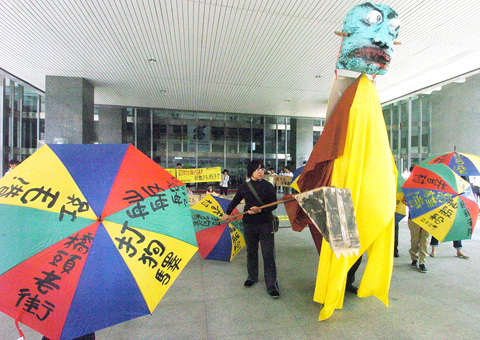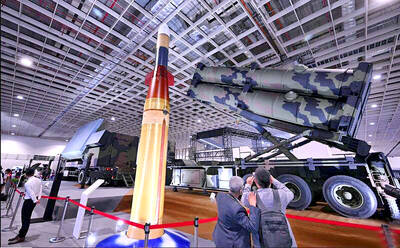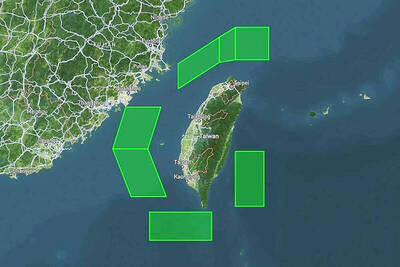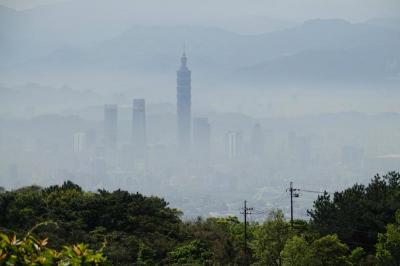When economic development dances with cultural heritage, it tends to result in something resembling a tug-of-war rather than a tango.
This struggle is perfectly illustrated by the relationship between a century-old train station in Kaohsiung and a city government preoccupied with efforts to boost the city’s economy.
Kaohsiung City Government has for years been dreaming of taking over jurisdiction of Kaohsiung Harbor from the Ministry of Transportation and Communications, partly because of the massive tax revenues the harbor can bring in.

PHOTO: HUANG JHIH-YUAN, TAIPEI TIMES
However, the harbor means more to the city than just its financial value, as it is the place where the city’s prosperity has its origin.
The harbor was inaugurated in the 1680s as a trade hub of Takao City (打狗), as Kaohsiung was then known.
Throughout the early 20th century under Japanese rule, the neighborhoods around the harbor — Hamasen (哈瑪星) and Yenchengpu (鹽埕埔) — grew much faster than any other parts thanks to the volume of traffic at the Takaoyi (打狗驛), now known as the Kaohsiung Harbor Station.
The station, established in 1900, was the city’s first railway station and controlled freight transport for southern Taiwan.
To accommodate the flow of goods in and out of the city, the train station operated 10 platforms connected to two harbor lines — one 13km route to what is now the downtown Kaohsiung Train Station and the other, 8.7km line to the Caoya (草衙) Switchyard in Siaogang (小港).
As the center of the city moved away from the harbor and highways replaced railroads in the freight business, the harbor train station’s influence gradually diminished, limiting its logistical value. The old harbor area withered as the station lost its economic importance.
After the Kaohsiung Harbor Station, including its platforms, was listed as a historical monument in 2002, the Kaohsiung City Government last year unveiled a plan to turn the surrounding area into a financial district.
A plan drawn up by the city government’s Urban Development Bureau calls for part of the 4.6 hectare harbor train station and its neighborhood to be turned into a 2 hectare financial district and a 0.5 hectare special cultural district.
The bureau also plans to introduce hotels and recreational businesses into the area.
The plan has drawn widespread criticism from local cultural groups and activists, who urged the city government to preserve the station and keep it intact, as they said it symbolized the city’s spirit.
“In 2008, the city government promised to turn the area into a railroad museum. The city government should keep its promise and think about how to revive the area instead of allowing construction companies to build houses there,” said Liu Chiu-er (劉秋兒), spokesman of the Takoayi Cultural Heritage Designation Alliance — an organization of about 30 local cultural figures.
Describing the city government’s plan as “totally wrong” and “unacceptable,” Liu said the alliance was never against developing the area, but the city government’s plan showed that “it had failed to connect the past [of the city] to its present and future.”
Liu said the alliance believed it would be better to revive the communities near the harbor by taking advantage of the station’s existing railways and the cultural landmarks along its two routes.
Rail services, which were taken out of service in November 2008, should be resumed and turned into a light rail transportation system, Liu said.
Such a system would be of value to tourism as there are numerous interesting cultural and artistic sites along the routes, including the Pier 2 Art District (駁二藝術特區) and a planned pop music center, he said.
Liu said the alliance planned to invite experts from relevant fields to deliberate the issues and pen another petition in greater detail for Kaohsiung Mayor Chen Chu (陳菊).
Lu Wei-ping (盧維屏), director-general of the city’s Urban Development Bureau, said the cultural groups should keep in mind that the residents of Yenchengpu and Hamasen would like to see the area renewed.
Lu said the old harbor area might face difficulties during renewal if the city government preserved every part of the station and did not introduce “proper business development opportunities and public facilities” to the area.
“Since Kaohsiung Harbor Station is a public asset, [the city government] should take both preservation of cultural heritage and urban development into consideration,” Lu said.
Hsu Ling-ling (許玲齡), a local cultural activist, said he feared that the century-old railway might be damaged during redevelopment.
Acknowledging the concerns, Kaohsiung’s Bureau of Cultural Affairs Director-General Shih Jhe (史哲) vowed to be cautious during the renewal process.

Taiwan is to commence mass production of the Tien Kung (天弓, “Sky Bow”) III, IV and V missiles by the second quarter of this year if the legislature approves the government’s NT$1.25 trillion (US$39.78 billion) special defense budget, an official said yesterday. Commenting on condition of anonymity, a defense official with knowledge of the matter said that the advanced systems are expected to provide crucial capabilities against ballistic and cruise missiles for the proposed “T-Dome,” an advanced, multi-layered air defense network. The Tien Kung III is an air defense missile with a maximum interception altitude of 35km. The Tien Kung IV and V

The disruption of 941 flights in and out of Taiwan due to China’s large-scale military exercises was no accident, but rather the result of a “quasi-blockade” used to simulate creating the air and sea routes needed for an amphibious landing, a military expert said. The disruptions occurred on Tuesday and lasted about 10 hours as China conducted live-fire drills in the Taiwan Strait. The Civil Aviation Administration (CAA) said the exercises affected 857 international flights and 84 domestic flights, affecting more than 100,000 travelers. Su Tzu-yun (蘇紫雲), a research fellow at the government-sponsored Institute for National Defense and Security Research, said the air

A strong continental cold air mass is to bring pollutants to Taiwan from tomorrow, the Ministry of Environment said today, as it issued an “orange” air quality alert for most of the country. All of Taiwan except for Hualien and Taitung counties is to be under an “orange” air quality alert tomorrow, indicating air quality that is unhealthy for sensitive groups. In China, areas from Shandong to Shanghai have been enveloped in haze since Saturday, the ministry said in a news release. Yesterday, hourly concentrations of PM2.5 in these areas ranged from 65 to 160 micrograms per cubic meter (mg/m³), and pollutants were

Taiwan’s armed forces have established response protocols for a wide range of sudden contingencies, including the “Wan Chun Plan” to protect the head of state, the Ministry of Defense (MND) said today. After US President Donald Trump on Saturday launched a series of airstrikes in Venezuela and kidnapped Venezuelan President Nicolas Maduro, concerns have been raised as to whether China would launch a similar “decapitation strike” on Taiwan. The armed forces regularly coordinate with relevant agencies and practice drills to ensure preparedness for a wide range of scenarios, Vice Minister of National Defense Hsu Szu-chien (徐斯儉) told reporters before a